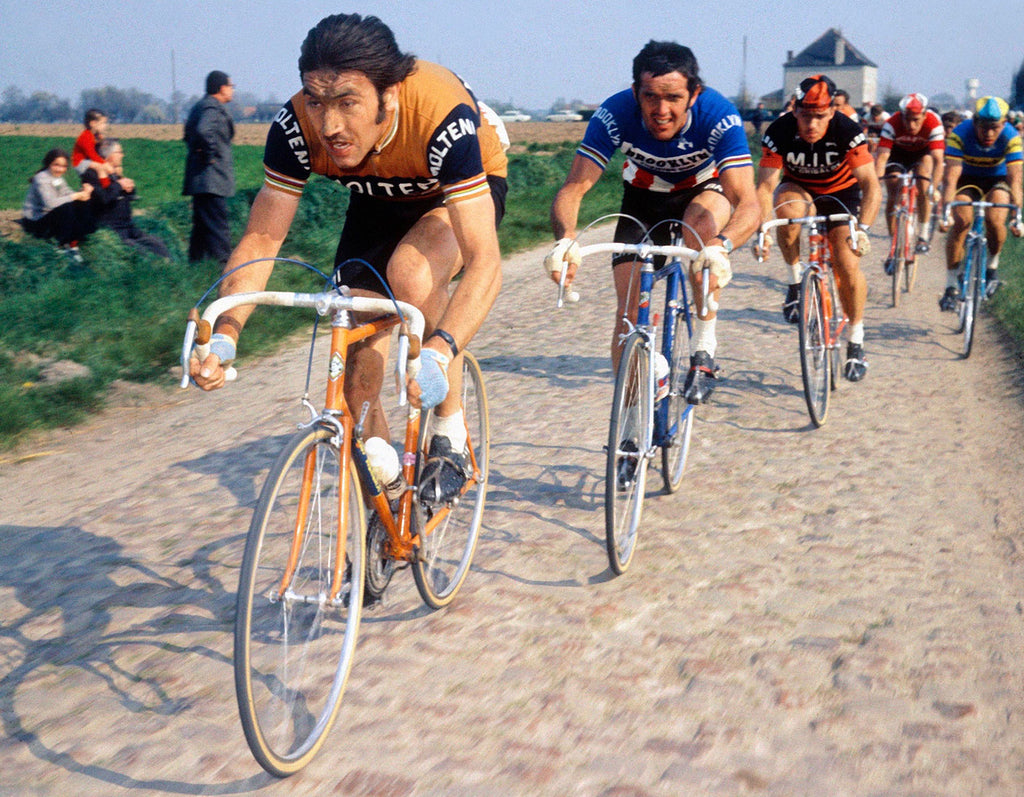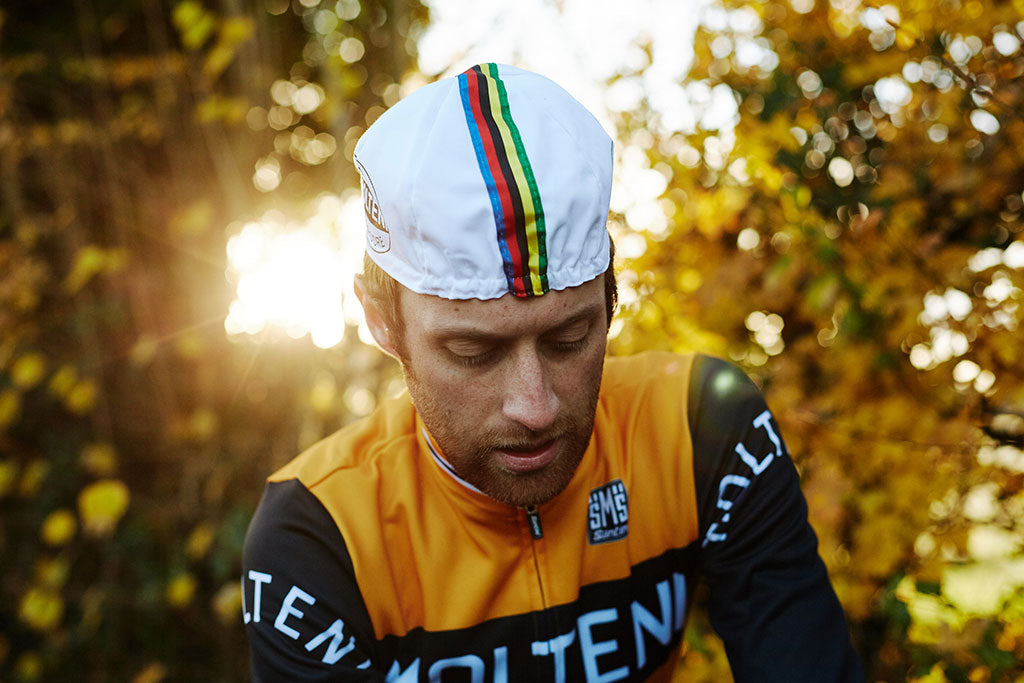QUALITY CYCLING CLOTHING SINCE 1996 - THE UK'S FIRST RETRO MANUFACTURER
QUALITY CYCLING CLOTHING SINCE 1996 - THE UK'S FIRST RETRO MANUFACTURER
RETRO APPAREL
COLLECTIONS
Cycling Clothing
ACCESSORIES
Molteni cycling team
March 06, 2019 4 min read

Eddy Merckx (pink jersey) rides with his Molteni Arcore teammates after his 1973 Giro D'Italia victory. Photo credits: Offside / L'Equipe.
The iconic Molteni Arcore jersey has been in our retro peloton for many years now, so why not find out about much more about one of the peloton's most formidable teams by joining Pedr Charlesworth who looks back in ore at the team's ruthless domination.
Molteni Arcore - In pursuit of a ruthless panache
The son of farmers from Burgundy, Raymond Riotte was a habitual creature. Rising at the crack of dawn each day, the Sonolor team rider was once again up at first light despite lacking cows to milk or hay to bale. It was the 10th of July, 1971, right the in the crux of the Tour de France when he found himself strolling the vacant corridors of the Orcières Club du Soleil. Savouring the last of the morning’s silence, he wandered quietly through the hotel basement until hearing a strange whirring noise emanating from an adjacent room. Stopping to peer through the doorway he did a double take, rubbing his eyes to make sure they weren’t deceiving him, there was a rider powering away on the rollers - Eddy Merckx.
If there ever was a sign that the days ‘routine’, ‘flat’ 251-kilometre stage to Marseilles would be anything but, this was it.
The seed had been sown previous evening whilst rapidly descending to the team hotel. Led by Merckx, the Molteni Arcore team riders had formulated an audacious plan of attack, one so ridiculous they could count on no one seeing it coming – but could it be done? With legs freshly warmed from the early roller session, they formed a ten-man orange stripe that stretched across the first row of riders on the start line. Commencing up at 1,800 metres on the cusp of a steep descent, the rest of the field slowly lined up as the morning sun began showing signs of the impending heatwave due to hit the country. Well, if things were warm now, that fired up orange stripe was about to unleash an inferno of suffering on the rest of the field – they had a point to prove.
The previous stage had seen an upset of epic proportions. Luis Ocaña had decimated the peloton with a glorious exhibition of attacking climbing up the Col de Porte before summoning a blinding solo finish up the Orcières-Merlette. Described by the famous French sports journalist, Philippe Brunel, as ‘the essence of cycling distilled into a perfume bottle’, the scent had certainly upset a few noses at the Molteni camp. As had the gargantuan 10-minute gap between their leader, Merckx and Ocaña.
The stunning display had left Ocaña certain of victory in Paris, and on this morning he could be seen eagerly lapping up the attention from inquisitive journalists stood beside the starting group. Upon seeing this, Molteni’s Rini Wagtman, or ‘White Blaze’, shot a glance at Merkcx – the heist was on.
As the flag lowered, ‘Blaze went off like an atomic bomb’ (his own words), whilst Ocaña was resigned to watching as the Molteni team's train exploded off the front in Wagtman’s jet stream, divebombing towards the valley below. What ensued was a five-hour game of cat and mouse that would go down in cycling folklore.
Molteni at the front of the peloton
Molteni’s riders rode at such a blistering pace that they crossed the finish line in Marseilles before the crowds and tv crews had time to assemble. Gaston Deferre, the mayor of Marseilles was furious, quipping ‘the Tour de France will never set foot in this city again as long as I live’. Sure enough, the Grande Boucle would only return in 1989, after Deferre’s death.
The heroic antics of the team weren’t enough to regain yellow in that stage alone, but the damage was done. With Ocaña’s complexion now matching his jersey, Molteni relentlessly attacked him at every opportunity; Merckx reportedly even tipped off a certain Belgian radio presenter with, ‘follow me today, I’m going to batter Ocaña until one of us breaks’. He was true to his word, winding up in Paris proudly wearing the Maillot de Jaune in a display of ruthless panache that the team were fearfully respected for.
This was the pinnacle of the Molteni Arcore cycling team's power in the peloton. A team of Italian origin created in 1958 that lasted until a dramatic financial exit in 1976. During that time they harvested an unforgettable roster of riders who produced some of cycling’s all-time most memorable displays.
Commencing with the ever-modest ’66 Giro winner, Gianni Motta, seven-time Bordeaux-Paris champion, Herman Van Springel, Marino Basso and of course, ‘The Cannibal’ Eddy Merckx.
The Molteni cycling team embodied true cycling heritage, stretching from the Dolomitian peaks of Lombardy to the cruel cobbles of Flanders. Over time, the team evolved from one cycling heartland to another, in synch with the waxing of Merckx’ star and waning of Motta’s.

Eddy Merckx (Molteni Arcore) riding hard at Paris Roubaix ahead of Roger De Vlaeminck (Brooklyn) and Herman Van Springel (M.I.C. Moneymakers). Photo credits: Offside / L'Equipe.
There’s an Italian expression, ‘L’appetito vien mangiando’ – appetite comes with eating, which concisely sums up their mentality of the time. They raced and won incessantly, leaving an exhaustive appetite permanently unsated. Yet, even during the height of the Merckxist era of Molteni domination - when most would have ridden defensively - the riders consistently produced gutsy, emotive performances from the saddle.
Long-time adversaries such as Walter-Godefoot today remark on the way they didn’t just win, ‘they demoralised’ their competitors. The sight of Merckx’s companion, Jos Bruyère, heading to the front of the pack would be a sure sign of a demolition derby to come, one that decisively ripped through the ’75 classics season.
Bullies in the peloton, ruthless in their execution, the Molteni cycling team would be forever known for their sheer resilience and dignity in racing during a golden era for cycling. Consequently, even after the Molteni brothers ran themselves into financial ruin through an elaborate smuggling ruse, the name still stands as strong as the iconic pillar of cycling it once represented.

Prendas Ciclismo stock a range of Molteni Arcore cycling team clothing for you to buy and enjoy.
Also in News and articles from Prendas Ciclismo

Prendas' Best-Selling Caps of 2024
January 21, 2025 4 min read
With 2024 in the books, we're looking back at your favourite caps of the year. From cult classic movies to the jungle with a whole lot of Italian flair, check out our best-sellers and grab a new cap!

Vas-y Barry! Hoban wins Ghent-Wevelgem for Gan Mercier Hutchinson
May 15, 2024 8 min read
In an extract from his autobiography, Vas-y Barry, the only British winner of Ghent-Wevelgem, Barry Hoban tells how he won the cobbled classic in 1974, beating Eddy Merckx and the cream of Belgian cycling.

Our Best Selling Caps of 2023
January 15, 2024 4 min read
We know caps here at Prendas Ciclismo, and we know that you love all the styles we have on offer. So every year, we look back at our best-selling cycling caps for the previous year for you to discover a few new styles. Is your favourite cycling cap featured on our list? Read on and see!
Subscribe
Sign up to get the latest on sales, new releases and more …

